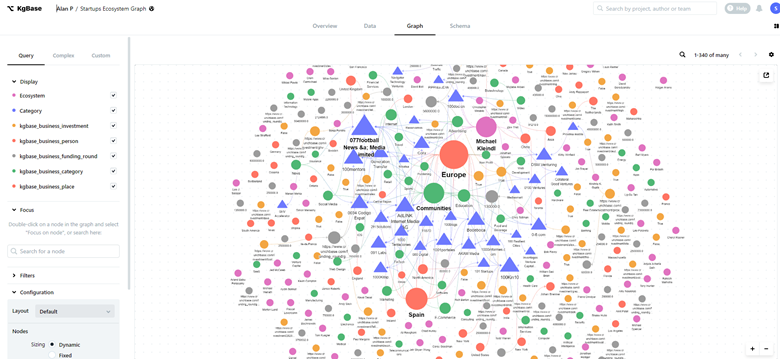No-Code Platforms for Open System Data Source Development: Save Time and Resources
No-Code Platforms for Open System Data Source Development: Save Time and Resources
Blog Article
Exploring the Benefits of Scalable Data Sources That Call For No Coding Skills for Effective Information Administration Solutions
The emergence of scalable data sources that remove the need for coding skills provides a transformative chance for organizations seeking effective information administration services. By allowing non-technical users to harness the power of data through instinctive user interfaces, these systems improve availability and foster cooperation throughout diverse groups. Furthermore, their cost-effectiveness and versatility to evolving organization demands can considerably simplify functional procedures. As we consider the ramifications of such advancements, it comes to be crucial to analyze how they can reshape the landscape of information monitoring and drive sustainable growth in an affordable atmosphere.
Enhanced Access for Users
Improved accessibility for users is a vital facet of scalable databases, guaranteeing that data monitoring systems are intuitive and user-friendly. In an age where data-driven decisions are vital, access enables a broader array of users, including those without comprehensive technical competence, to engage with database systems successfully. This democratization of information gain access to assists in boosted cooperation throughout departments, empowering workers to remove insights and make educated decisions.
Straightforward user interfaces, such as drag-and-drop features and visual information representation, streamline complex information interactions. These improvements lower the understanding contour connected with standard database management, allowing users to focus on leveraging data as opposed to grappling with technical complexities. In addition, scalable databases often incorporate adjustable dashboards and real-time analytics, supplying customers with instant insights tailored to their specific demands.

Cost-Effectiveness and Resource Cost Savings
Reliable information monitoring not only rests on availability however also on cost-effectiveness and resource cost savings. Scalable databases developed for users with no coding abilities significantly reduce financial worries typically linked with standard data source administration systems. By getting rid of the demand for specialized programs expertise, organizations can allot their resources extra efficiently, concentrating funds on core business tasks instead of extensive training or employing competent workers.
In addition, these databases commonly utilize cloud-based services, which even more decrease costs associated to equipment and maintenance. Organizations can scale their data source options according to their demands, staying clear of the expenditures incurred from over-provisioning resources. This adaptability means businesses can adapt to changing demands without sustaining unneeded prices, resulting in considerable lasting cost savings.
Additionally, user-friendly user interfaces improve data entrance and administration processes, reducing the time invested in administrative jobs. This effectiveness converts right into labor cost savings, permitting teams to focus on calculated efforts as opposed to routine upkeep. Overall, adopting scalable databases that require no coding abilities cultivates an extra economical strategy to information administration, allowing companies to optimize their sources while preserving high degrees of operational effectiveness.
Improved Collaboration Across Teams

Moreover, scalable databases facilitate smooth communication among team participants. With straightforward user interfaces that call for no coding abilities, staff members can easily create, modify, and share reports or dashboards customized to their certain requirements. This democratization of information empowers non-technical individuals to contribute insights, enhancing the collaborative setting.
Furthermore, these databases sustain concurrent gain access to, enabling numerous individuals to deal with the very same dataset concurrently. This feature boosts productivity, as groups can take part in joint data analysis without the risk of variation control concerns. The ability to leave comments or notes straight within the database additionally advertises discussion and makes clear data interpretations.
Streamlined Information Monitoring Processes
In today's data-driven atmosphere, have a peek at these guys organizations identify the requirement of streamlined data administration refines to make the most of efficiency and accuracy. By leveraging scalable databases that call for no coding skills, services can simplify their information handling and minimize the complexities normally connected with typical data source systems. This availability equips non-technical customers to involve directly with information, facilitating quicker decision-making and decreasing reliance on specialized IT personnel.
Structured data administration processes boost operations by automating regular jobs such as data entry, recognition, and reporting. Automated data combination guarantees that information from different sources is accumulated perfectly, removing silos and cultivating a linked view of critical organization metrics (no-code). Easy to use interfaces allow workers to adjust data easily, allowing them to create understandings that drive critical efforts without the requirement for considerable training.
This performance not only accelerates operational processes however additionally minimizes the capacity for human mistake, ensuring that information remains dependable and exact. Inevitably, structured information administration procedures with scalable databases cause enhanced efficiency, allowing companies to concentrate on core activities while guaranteeing that their information administration practices are effective and reliable.
Scalability for Expanding Companies

For broadening enterprises, the capability to scale up or down is important. A scalable data source can take care of an increase of data generated from brand-new consumers, products, or solutions, ensuring that company procedures stay nonstop. Furthermore, these databases give the capacity to handle peak tons efficiently, which is More hints necessary during durations of rapid growth or seasonal spikes.
Furthermore, numerous scalable data source services are developed with straightforward user interfaces that require no coding skills, empowering non-technical staff to take care of data properly (no-code). This democratization of information management permits organizations to allocate resources strategically and minimize dependency on useful site specialized IT employees
Ultimately, embracing a scalable data source not just improves functional efficiency yet additionally promotes a setting where businesses can introduce and evolve without the restraints of traditional data source systems. This flexibility placements companies for long-term success in today's affordable landscape.
Final Thought
In conclusion, scalable data sources that need no coding abilities supply substantial advantages for reliable data administration. By simplifying information management processes and using scalability for growing businesses, such solutions enable companies to adjust to changing demands properly.
Boosted ease of access for customers is a crucial element of scalable databases, making certain that data monitoring systems are straightforward and instinctive.User-friendly user interfaces, such as drag-and-drop features and aesthetic data depiction, streamline complex information interactions. Generally, embracing scalable data sources that require no coding abilities cultivates a much more affordable strategy to data management, enabling organizations to optimize their resources while preserving high degrees of operational efficiency.
By leveraging scalable data sources that need no coding abilities, businesses can simplify their data handling and decrease the intricacies normally connected with standard data source systems - no-code.Streamlined information monitoring processes boost process by automating routine tasks such as data entry, recognition, and reporting
Report this page